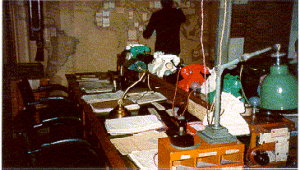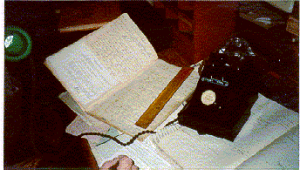
Beginnings …… THE CABINET WAR ROOMS
The discovery of the unchanged Churchill War Rooms in London – the first in the continuing “living history” series – came about, as did most of the situations in the articles to follow – quite by accident. (An expanded and updated version of this article is one of the chapters in The Hidden Places of World War II.)
In 1978, a former RAF pilot friend told me about Winston Churchill’s top secret headquarters, as we rocketed at high speed on the motorway between London and Oxford. He had been informed that Churchill’s wartime HQ not only still existed, but was virtually unchanged and fully intact. He said that a few VIP guests such as military officials and diplomats, were occasionally allowed to visit the enclave for tours conducted by a solitary employee functioning as both guide and curator. After much pleading my friend convinced the guide and curator, a Mr. Christian Truter, that a minor military record and a journalism background merited me a special tour.
The next morning we descended into the cluttered warren of rooms and records, the appearance of which suggested that the occupants had suddenly departed the premises – perhaps for afternoon tea – decades ago, never to return to wartime posts staffed for six years. We were given tiny one-cell military flashlights, told to keep our heads down to avoid low overheads, and set off ever deeper into a rarely seen subterranean world. It was a memorable adventure into the living history of the 20th Century’s defining event – World War Two.
Scattered throughout more than 10,000 sq. ft. of alternately spacious and cramped rooms, masses of overflowing files and unruly papers, documents and reports were idly scattered on tables, desks, chairs, atop filing cabinets and on virtually any flat surface. Large maps and charts anchored almost every wall. Color-coded telephones, loose-leaf binders, and office supplies from a bygone era littered the trestle tables and desks. Quite by accident – although it could hardly have been avoided amidst the disorder – I knocked over a yellowing, brittle manila folder. A typed label identified the contents: OPERATION OVERLORD – TOP SECRET. It was a planning folder for the Normandy invasion. Returning the file to its more or less correct location, I imagined the price Hitler would gladly have paid to read the contents of that folder.
But first Hitler had to know that the headquarters of one of the two men he hated and feared most (FDR being the other), was in the heart of London, the VERY heart of London. It was only steps from Number Ten Downing Street, a short walk from Buckingham Palace, around the corner from Trafalgar Square, and directly across from St. James Park – a perfect landing site for paratroopers. His principle enemy’s nerve center was hiding in plain sight and easily accessible to anyone, or, at least, anyone with the proper clearance to be there. And there weren’t many.
Thus began the first in the still-continuing series of articles revealing – often for the first time – places and events of great importance, events affecting the lives of everyone living in the Twentieth Century – history’s most tumultuous one hundred years.
The below article and the accompanying photos appeared in the Chicago Tribune Sunday Magazine on October 15, 1977. It was the first major feature revealing the existence of the now famous rooms, and led to their opening as a museum in the early 1980s, now one of London’s most visited. For WWII history enthusiasts, a visit to London will not be complete without seeing the Cabinet War Rooms. But be ready to wait. During a recent visit the entrance line snaked outside and around the corner of the still unchanged building.
Additional articles and commentary will appear periodically. Every effort will be made to reply to comments and questions. Contact the author here.
UNVEILING THE CHURCHILL WAR ROOMS
Chicago Sunday Tribune Magazine, 15 October 1977
Although few are aware of its existence, tourists may now visit the subterranean bastion in London from which Prime Minister Winston Churchill directed Britain’s war effort
By Jerome M. O’Connor
It’s in the center of London, only five minutes walk from Buckingham Palace, and not long ago was considered to be the most impregnable and top secret bastion in Britain. To obtain access to its innermost sanctum, one had to first pass a hidden machine gun post in the entry, then descend a winding stairway past three control points manned by Royal Marines ready to deny further passage to those without the proper code word for the day. This “holy of holies,” known as the Churchill War Rooms, is more accessible now to small daily tours, but is practically unknown to most Londoners and visitors, many of whom walk daily over its miles of serpentine passages twisting below the traffic.
In 1906 construction began on the white stone building facing St. James Park, but it wasn’t finished until 1916, then turned over to the Ministry of Works as an office building. The remains of deep wine cellars from the stately homes that earlier occupied the site would later serve as the starting point for the network of chambers, tunnels, offices, and dormitories that Churchill and his staff referred to as the “Annexe.”
The decision to move into the fortified Annexe and its recently finished basement War Rooms was made on October 14, 1940, as the Prime Minister and Mrs. Churchill dined at No.10 Downing St. A bomb exploded fifty yards away and the blast had destroyed the kitchen, pantry and offices of No. 10. As the air raid continued, the Churchill’s calmly walked through bomb-cratered St. James Park to the roof of the nearby Annexe building to watch the fires searing parts of Pall Mall, St. James and Piccadilly. That night they moved into the war rooms, to sleep, however reluctantly, during the heaviest air raids.
Wartime Londoners were not unaware of the existence somewhere in the capital, of a bomb shelter designed for Churchill, but they assumed it to be in the Citadel, the grim looking concrete pile at the Horse Guards Parade, which Churchill called “that vast monstrosity.” Little did they know that the Citadel, with its twenty foot thick reinforced concrete walls actual contained only offices for female army Wrens and a cinema, while the nearby and much more vulnerable Annexe housed the Churchill’s, the War Cabinet and the Defense Committee, as well as hundreds of staff and troops. To this day, most Londoners believe that Churchill masterminded the war from the Citadel, now converted into luxury apartments for government ministers, while the Annexe, since re-named the Ministry of Works building, with its vast storehouse of history, is still largely unknown.
Today the Churchill War Rooms are maintained as a shrine to the spirit of a people who denied Hitler his most sought after prize, England, and to the bulldog tenacity of the man who gave Britain hope and courage when the rest of the world expected surrender. Until this spring (1977) they faced a different crisis, a lack of funds to maintain the crumbling relics of the Battle of Britain. Now the Imperial War Museum has stepped in with money to sustain for another year or two, the daily trickle of visitors to a museum without glass. While the battle of permanent funding continues, the 2 ½ hour tour is an unforgettable and sometimes chilling reminder of Britain’s darkest days.
The sole guide and curator, Christian Truter, about 53, was as surprised as everyone else to learn that the War Rooms were actually under the Ministry of Works Building not the Citadel when he was assigned as the first permanent guide in August, 1975; he had been a guide in one of Britain’s stately homes. Since then, his job has become an avocation and much of what is known today about what happened then was gained from personal interviews, then a meticulous re-assembling of the original furnishings, equipment and documents. So vivid was the realization that William Stephenson, about whom the best-seller, A Man Called Intrepid, was written, broke into tears when he visited the rooms two years ago for the first time since the war.

A maximum of fifteen participants are given flashlights for a part of the tour going below the level of the Thames, then beneath the sewer level to view the former offices and dormitories, the occupants of which, judging by the overhead, must have been shorter than Britain’s legendary Gurkhas. During the war secretaries with top security clearances, the “secret ladies,” performed staff functions from damp, dungeon-like warrens. Passageways were lit by candles, while overhead pneumatic tubes whistled and pinged from the sounds of message canisters being propelled from one post to another. William J. (Wild Bill) Donovan, head of America’s wartime OSS, likened the activity of the War Rooms to stepping into a Shakespearean play complete with stage directions like, ‘army heard in distance, sound of trumpets.’ Outside the map room a sign post had slots describing the weather overhead, COLD, SUNNY, WINDY, FINE. Either optimism or wishful thinking dictated that there be no sign for RAIN. General Eisenhower’s cell-like room, with its army cot and dresser remain as he left it. A “schedule of alarms” posted outside Ike’s room proclaims the type of perils to which the staff could be subjected, including fire, air raid overhead, gas, or ground attack in or outside the building. A notice near the Prime Minister’s bedroom warns that, “there is to be no whistling or unnecessary noise in this passage.”
The enclave was protected by so many layers of secrecy that a recent visitor was amazed to discover the existence of a map room manned 24 hours a day between 1939-45, and adjacent to the room which was his duty station for the entire war. The map room appears as if its occupants had left for tea, expecting to return soon to the red, yellow, white and black telephones on the cluttered desks, still heaped with top secret codes, clearances, books and maps. Large area maps on the walls also display thousands of pinholes tracing the dangerous paths of convoys around the world, including New York, Gibraltar, or frozen Murmansk. Almost lost in a corner of the organized disarray is a frayed empty map case with the legend, “Operation Overlord Maps, War Cabinet Chiefs of Staff, 30 July, 1943.” It contained maps of the Normandy invasion beaches, for which Hitler would gladly have paid any price to obtain their precious contents.
One map shows the progress of the last air raid on Berlin. Detailed reports reveal the amount of destruction in Britain caused by the V1 and V2 bombs. Status boards tell how close enemy bombers were to London. One board has a white chalk entry recounting how many British and German planes fought and were shot down on the final day of the Battle of Britain, September 15, 1940. On that day Hitler indefinitely postponed “Operation Sea Lion,” the invasion of Britain.
Only steps from the map room, Churchill’s bedroom door is marked “Prime Minister.” The austere 18X20 ft enclosure has a cot occupying one end and a desk and chair at the other. From the simple desk were made the stirring broadcasts that rallied and sustained the nation and a defeated Europe. In the unlikely event that the great man faltered in composing his calls to battle, a pocket size version of “Dod’s Parliamentary Companion” on the desk awaited his perusal.
Covering an entire wall of the bedroom, a map of the British Isles showed the color coded invasion beaches where Hitler was expected to launch the attack on England. This information was so sensitive that even here in Churchill’s bedroom in the center of the most secret place in England, heavy drapes covered the knowledge that even Churchill expected the worst for England. The only personal memento in the room is an antiaircraft shell base to collect his numerous cigar ends, later to be mysteriously smuggled out and sold on the streets (along with thousands of others, no doubt) as genuine “Churchill cigars.”
In his anthology of the Second World War, Churchill describes in “Their Finest Hour”, how Lady Clementine, despite Mr. Churchill’s preference for unadorned walls, had sufficient confidence in “this solid stone building,” to hang favorite pictures in the austere living quarters.

The first transatlantic hot-line was installed in a nearby cubicle everyone thought was the PMs personal toilet. In true Churchillian fashion, he didn’t take telephone calls from the operator until certain that Roosevelt was first on the line. At his end of the telephone, an annoyed FDR was constantly awakened in the middle of the night to take calls being placed early in the morning London time. That problem was solved by the addition of a red painted indicator on the wall clock showing Washington time in relation to London time.

The visit to the Cabinet Room is the tour’s emotional highlight. Numerous times between 1939-45, war cabinet meetings were held in this room, usually between Midnight and 2am. These “Midnight follies” were led by Churchill, who padded into the room in robe and slippers with attached pom-poms, trailing a plume of cigar smoke. He occupied a wooden chair with leather upholstered seat (see photo). A large wall map mounted behind was constantly referred- to by the Prime Minister. On the floor at Churchill’s right side, a bucket occasionally caught the cigar butts unceremoniously tossed over his shoulder. The table in front, covered in the same sturdy black cloth used to make police uniforms, held a red painted wooden dispatch box for the Prime Minister’s documents. In a hollow square around Churchill sat his ministers and the chief architects of Britain’s wartime policy. A hand lettered and tattered placard on the table admonished all that; “there is no depression in this room and we are not entertaining the possibilities of defeat; they do not exist.”
To a hushed tour group four decades later, seated at the same table where England’s survival was discussed, a recording of Churchill’s war speeches is played. As the sonorous sibilance echoes throughout the room, each participant became part of one of the century’s most moving experiences.
What General Weygand called the “Battle of France” is over. I expect that the Battle of Britain is about to begin. Upon this battle depends the survival of Christian civilization. If we fail then the world, including the United States and all that we have known and cared for will sink into the abyss of a new dark age made more sinister and perhaps more prolonged by the likes of perverted science. Let us therefore brace ourselves to our duty and so bear ourselves that, if the British Commonwealth and Empire last for a thousand years, men will still say, “this was their finest hour.”
The biggest secret about the existence and purpose of the Churchill War Rooms wasn’t known until 1976 when the British government revealed that a single 500 pound bomb could have damaged the Annexe and destroyed the War Rooms. It would have stilled the rolling resonance of the voice that gave wartime Britain its roar.
Most Londoners are unaware of the historical treasure under their streets. Only 75 visitors a week make the advance reservations necessary for the tour. But the rooms are open and visitors are welcome. To miss the Churchill war rooms when in London is to miss an important part of 20th Century history.
![head[1]](https://historyarticles.com/wp-content/uploads/2013/09/head1.gif)
